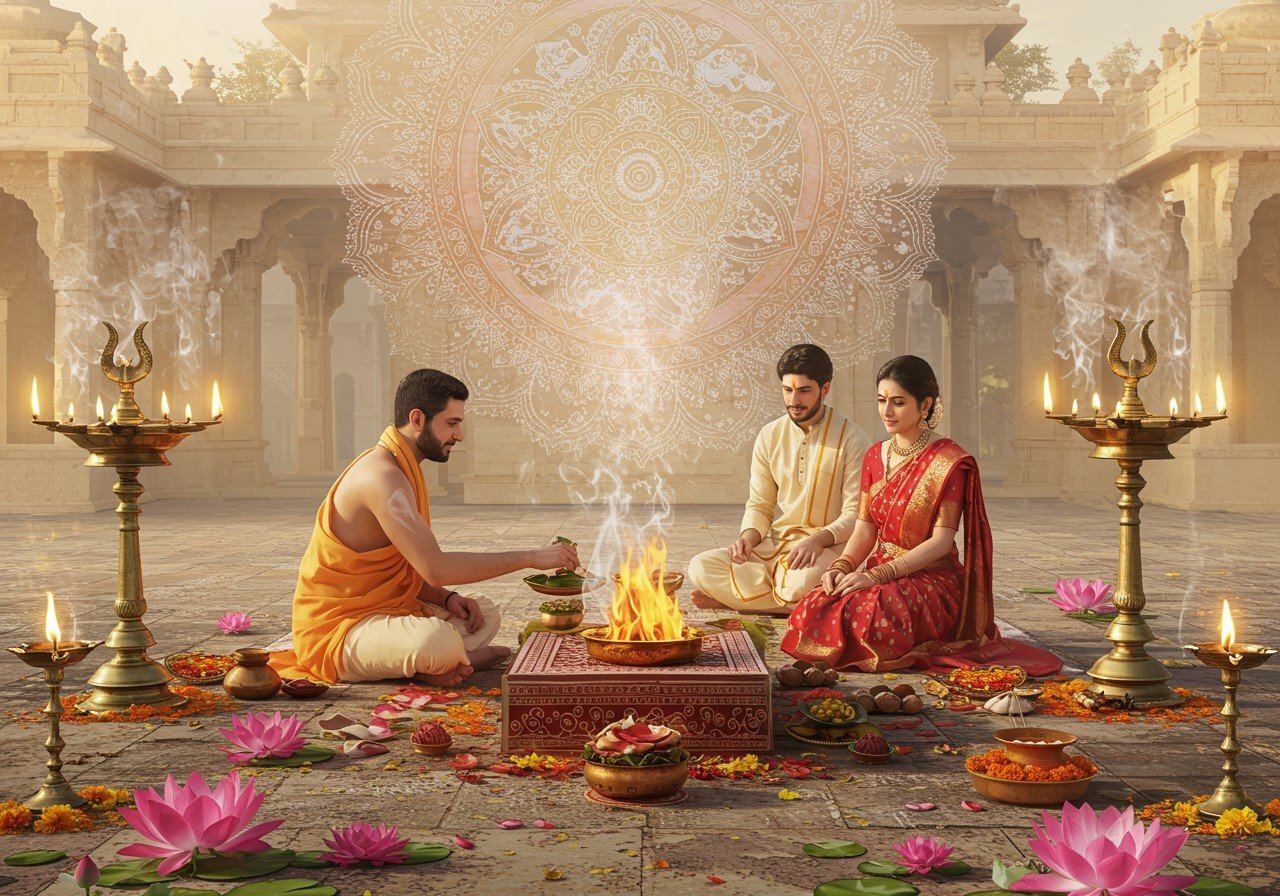
The Putrakameshti Yagna offers a glimpse into a cherished Hindu tradition, deeply rooted in our history and spirituality. This ancient ceremony seeks divine blessings for the gift of a son, a desire holding significant cultural value for many Indian families. Let’s explore the essence of the Putrakameshti Yagna, its place in modern society, and its traditional importance.
A Journey Through Time: Origins of Putrakameshti Yagna
The Putrakameshti Yagna’s roots lie deep within ancient Hindu scriptures. The Ramayana itself speaks of King Dasharatha performing this ritual for sons, highlighting its historical and mythological significance. The Yagna invokes divine intervention, with the participation of learned sages and deities. In Hindu society, it symbolizes the continuation of one’s lineage, a cherished cultural and religious aspiration. This ritual signifies the importance of family and传承 in our culture.
Unfolding the Ceremony: The Procedure of Putrakameshti Yagna
Embarking on the Putrakameshti Yagna is a profound spiritual experience. The journey begins with selecting an auspicious date and a sacred location, guided by the wisdom of Vedic astrology, aligning the Yagna with cosmic energies. Preparations include arranging essential items like the havan kund, pure ghee, and specific herbs, each element holding deep spiritual meaning and enhancing the ritual’s sanctity.
A learned Purohit, our revered priest, guides the Yagna, chanting sacred mantras and invoking divine blessings. These mantras create a spiritually charged atmosphere, believed to carry the couple’s wishes to the heavens.
The Yagna unfolds in phases, starting with the Sankalp, where the couple declares their heartfelt intention. Offerings into the sacred fire follow, symbolizing purification and transformation. The ceremony culminates in the Purnahuti, the final offering, marking the completion of the prayers. Each step carries deep cultural and spiritual weight, representing not just the desire for a son but a holistic journey of faith and devotion, reflecting the cherished values of Hindu traditions where lineage and dharma are intertwined.
Understanding these rituals helps us appreciate their significance in our modern world. While some may view them as relics of the past, others find solace and purpose in their practice, connecting with their roots and spiritual aspirations.
The Heart of the Ritual: Significance and Beliefs
The Putrakameshti Yagna resonates with profound beliefs about family, lineage, and the continuation of one’s legacy. In Hindu culture, having a son has traditionally been seen as a way to ensure the family name continues, a concept deeply intertwined with fulfilling one’s dharma, or duty. This Yagna is seen as a channel for divine intervention, a testament to the belief in a higher power capable of blessing families with children to carry their legacy forward.
In contemporary times, perceptions of these rituals are evolving. While many families hold steadfast to traditional beliefs, others are engaging in conversations about gender expectations. The ritual’s continuing relevance lies in its capacity to adapt while honoring our cultural heritage. Approaching these traditions requires sensitivity and respect for the diversity of viewpoints, fostering understanding and dialogue.
Navigating the Complexities: Challenges and Controversies
In today’s world, the Putrakameshti Yagna faces its share of challenges. Societal pressures regarding male offspring often spark ethical discussions, particularly concerning the impact on women’s rights and family dynamics. As gender roles evolve, so too do our perspectives on these rituals. Balancing tradition with contemporary values raises questions about the place of these cultural practices in modern India.
Evolving legal frameworks championing gender equality further shape how families approach these rituals. Engaging with these traditions requires understanding their historical context and aligning them with present-day ethical considerations.
Tradition Meets Modernity: Adaptations and Online Access
The Putrakameshti Yagna has gracefully adapted to modern lifestyles. Online platforms now offer virtual participation, extending accessibility and convenience to those seeking to connect with their heritage. Authentic ritual items are readily available online, catering to individuals who value tradition yet embrace the conveniences of modern life.
As families navigate the confluence of tradition and modernity, new avenues emerge to honor rituals while respecting evolving norms. This adaptability reflects the dynamic nature of cultural practices within a transforming society.
Poojn.in: Your Partner in Putrakameshti Rituals
Poojn.in simplifies your preparations for the Putrakameshti ritual by offering all the necessary items in one convenient location. As India’s leading Dashakarma bhandar, we offer:
- Complete Putrakameshti puja samagri kits, meticulously curated with every essential item.
- High-quality, authentic ritual materials sourced directly from trusted suppliers, ensuring the sanctity of your ceremony.
- Detailed lists specifying the items and quantities required for your convenience.
- Convenient home delivery throughout India, bringing the sacred to your doorstep.
- Expert guidance on specific puja requirements, offering support and clarity throughout your journey.
For personalized assistance with Putrakameshti puja items:
- Call us: 03369029784
- WhatsApp: 9476142738
Related Products at Poojn.in:
- Putrakameshti Puja Kit
- Individual puja items are also available to cater to your specific requirements.
- Garbhadhana Sanskar: A ritual for couples when conceiving, involving purification and strengthening through a “sattvic” diet and spiritual lifestyle for both partners. Purification may involve abstaining from intimacy for a minimum of 40 days before conception.
- Havan (Prayers): A Yagna (fire ceremony) performed before conceiving, with mantras praising the wife, saluting natural forces, and requesting a healthy pregnancy and an exceptional child. This involves invoking divine blessings for a healthy and virtuous son.
- Timing: Intercourse on days 6, 8, 10, 12, 14, and 16 from the start of menstruation is considered auspicious for conceiving a male child, according to traditional texts. These days are believed to be energetically favorable for conceiving a son.
- Ayurvedic Methods: Ayurveda suggests 4-16 days after menstruation as the optimal time for conception, with even-numbered days being conducive for a boy. Parental positions and breathing patterns during intercourse are also thought to influence the baby’s gender. Ayurveda emphasizes a holistic approach to conception, considering various factors.
- Santhana Gopala Mantra: This mantra, dedicated to Lord Krishna’s child form, is chanted with pure intentions to attract divine blessings for conception, particularly for a healthy and beautiful child. The mantra is: “Om Shreeng Hreeng Kleeng Glaung Devakisut Govind Vasudev Jagatpate Dehi Me Tanayam Krishn Tvaamaham Sharanam Gatah,” meaning, “I surrender to you, give me a son, Oh Krishna, son of Devaki, Lord of the universe.” Chanting this mantra is believed to invoke Krishna’s blessings for a son. You can explore more about Saraswati Puja and Dashakarma items on Poojn.in. Saraswati Puja Dashakarma Kit could be helpful.
- Dietary Rituals: Oral tradition suggests that couples desiring a learned son should prepare and consume boiled rice with meat or other protein and butter. This practice is believed to nourish the mother and contribute to the child’s intellect.
Note: Perishable items like fruits, flowers, and milk should be purchased locally before the puja. Our customer service team is always available to assist you in selecting the perfect items for your ritual needs.
Embracing Tradition in Our Modern World
The Putrakameshti Yagna stands as a testament to India’s rich cultural heritage and spiritual depth. It invites us to explore the timeless values that shape our identities and beliefs. While rooted in ancient customs, its essence resonates deeply with many families in contemporary times.
As we navigate the digital age, the online accessibility of the Yagna highlights how seamlessly tradition can intertwine with modern convenience. Regardless of geographical location, individuals can engage meaningfully with these rituals, connecting with their heritage.
Balancing tradition with modern values prompts us to reflect on what truly matters. It fosters open dialogue on gender roles, family expectations, and the core of our faith. By honoring these rituals, we pay homage to the wisdom of our ancestors while adapting to the ever-evolving needs of our time.
Ultimately, the Putrakameshti Yagna signifies more than the desire for a child; it represents a journey of faith, devotion, and the continuation of our cultural legacy. Engaging with these practices strengthens our connection to our roots, nurturing appreciation and understanding in a world that is constantly changing.
FAQs: Exploring Putrakameshti Rituals
What is the Putrakameshti Yagna? It’s a Vedic ritual performed to invoke divine blessings for conceiving a child, deeply rooted in Hindu traditions and aimed at fulfilling the longing for progeny. It is a sacred ceremony that honors the desire for children and seeks divine grace.
How is the Putrakameshti Yagna performed? It involves consulting a qualified priest who will guide the process, which includes specific chants, offerings, and a sacred fire ceremony, all conducted with utmost devotion and adherence to Vedic guidelines. The priest’s expertise is crucial in ensuring the ritual is performed correctly.
What offerings are made during the Yagna? Offerings such as ghee, grains, and specific herbs are offered into the sacred fire. These symbolize nourishment, purity, and devotion, and are integral to seeking the blessings of the deities.
How long does the Yagna typically last? The duration can vary depending on the specific customs and the presiding priest. Generally, it can take several hours to complete, requiring patience and reverence from the participants.
Who can perform the Putrakameshti Yagna? Usually performed by couples longing for a child, the ritual underscores the importance of a learned priest to ensure its proper execution according to Vedic scriptures.
What is the significance of this Yagna? It is deeply significant for those who believe it can help fulfill the desire for a child. As a spiritual practice, it offers a connection to divine blessings and provides hope for a family’s future generations.
Are there specific days for performing the Yagna? Yes, it’s typically performed on auspicious days recommended by astrologers or priests based on the couple’s astrological charts. These carefully chosen days are believed to enhance the ritual’s efficacy.
How should one prepare for the Putrakameshti Yagna? Preparation involves identifying a learned priest, gathering the necessary ritual items like roli and havan samagri, and cultivating a pure and focused mindset. Following any specific instructions provided by the priest is crucial for a successful ritual. You might also need items like a baran dala. Preparation also involves mental and spiritual purification to create a receptive environment for divine blessings.
Traditional Beliefs for Conceiving a Son
While there’s no guaranteed method to determine a child’s sex, some traditional Hindu beliefs and rituals are thought to enhance the chances of conceiving a son:
Explore a wide range of puja samagri and other ritual needs on Poojn.in’s puja samagri page.


